Fifty-two days at Nananu-I-Cake! A sufferer of “itchy anchor syndrome”, who would have guessed I (Margy) would have let Whistler remain in the same anchorage for that long? It was an interesting and active time for us.
We arrived at Nanana-I-Cake Island (pronounced Nananu-I-Thake) with S/Y Fusio on June 21st. For a few days, it was dead calm, good paddle boarding weather!
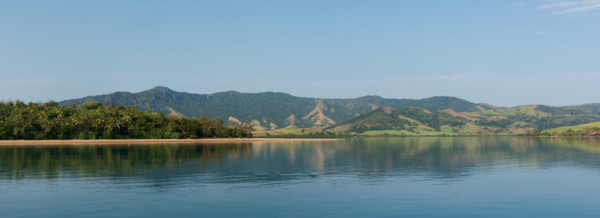
To our east and southeast is the sandy beach and Kite Point on Nananu-I-Cake Island. South of the island are the cane fields and green hills (rising to 540m) on the mainland of Viti Levu.

Looking south-west from the anchorage.

Looking west.
Then “enhanced tradewinds” kicked in for several days. We experienced “smoke on the water” with gale-force gusts up to 44 knots.
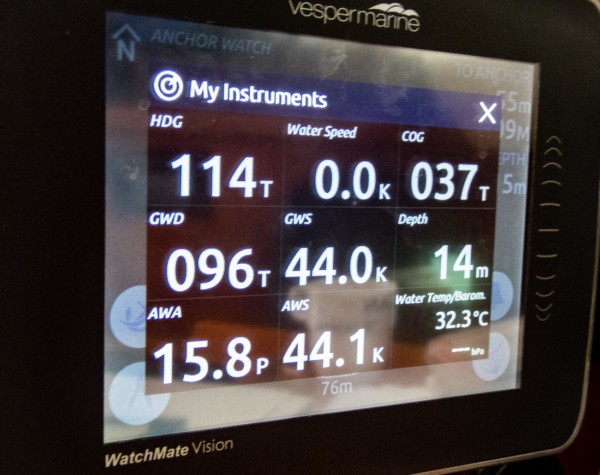
It was too windy to safely put our dinghy in the water or to kite, so we stayed on board doing boat jobs and playing King’s Cribbage. Every inch of Whistler’s decks, hatches, portlights and hulls were covered in salt spray.
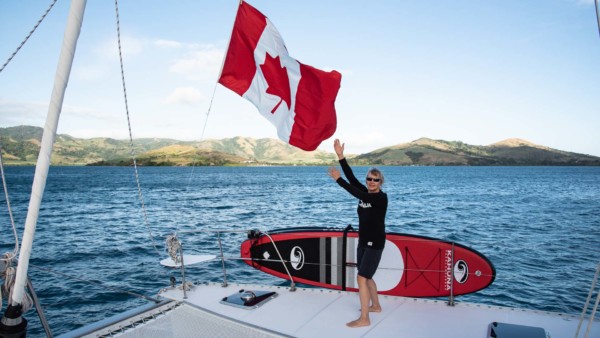
On July 1st, we celebrated Canada Day. We raised our big flag but had to take it down a few minutes later as the gusts were too strong!
This area, off the northeast corner of Viti Levu, is a dry spot! Over the seven weeks, we had only a few showers that amounted to maybe an inch in a catch bucket and a few sprinkles. The showers yielded a few rainbows.
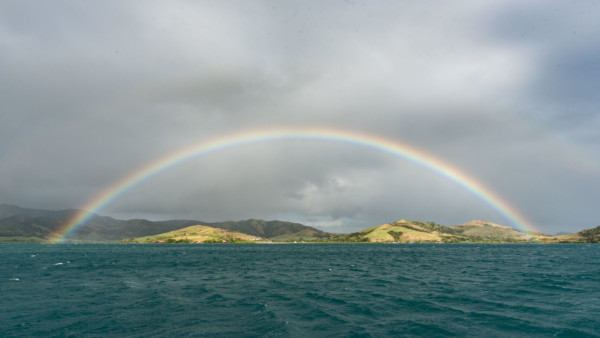
July 2, 2018. Note the white caps in the anchorage.
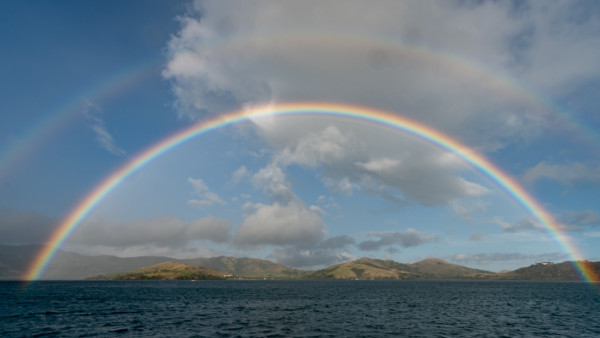
July 6, 2018
The island has been privately owned by a Swiss family for many years but the beach is free for all to use. They keep at least 8 horses on the island and we heard they had a full time horse trainer. Visits from the family are apparently rare.
Glass and plastic make their way into the sea and wash up on the windward shores all over Fiji. The island caretaker would occasionally come to Kite Point and pick up garbage and logs that had washed up. He would rake the leaves and light a few fires to burn the debris.
While Monty was kiting, I frequently scouted the beach to pick up broken glass that might be a danger to us kiters walking on the sand. I could pick up over a dozen jagged pieces of glass in a few minutes but mostly away from the main launching area. We never heard of anyone hurting themselves and most kite barefoot. I also gathered up the all kinds of plastic which are a hazard to fish and birds, just to do a little something to help the environment. Fiji recently instituted a $0.20 charge for plastic grocery bags in an effort to get people to reduce the use of plastic.
We had one weird incident at the beach. Monty was getting ready to push the dinghy off the sandy beach when he felt a terrible sting. He looked at his foot and saw blood oozing from a small pinhole sized puncture. He wondered what had wounded him. He said the pain was excruciating, like nothing he had felt before, other than a kidney stone! We got back to the boat and cleaned the tiny hole. We called Warren and asked what had gotten him. He instantly knew it was a stingray sting. Monty must have stepped on or too close to him. Warren told him to immerse his foot in water as hot as he could stand to neutralize the pain. He soaked it in near boiling water which did help. It took about 90 minutes for the pain to subside. He was back out kiting in 2 hours, so not very serious! The puffiness on his foot is still evident a month later.
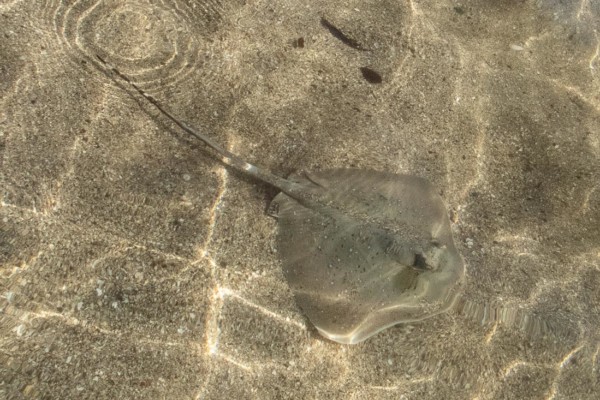
Likely the offending stingray a few days later! We watched carefully where we walked after that!
Sundays could be busy at Kite Point with locals occupying the beach. On this occasion a large group of Fijian and Indian Fijians came for a picnic, games and bonfire. I was pleased to see that they took most of their garbage with them.
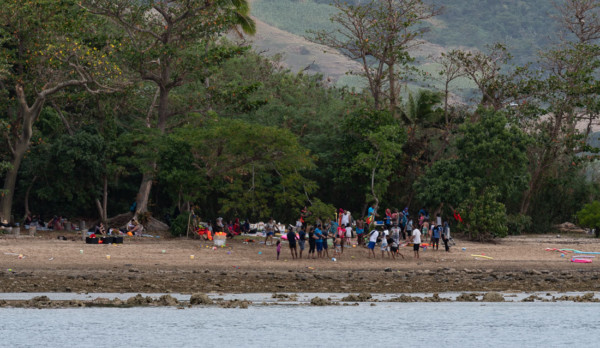
Fijians enjoying time at the beach and even a tug of war!
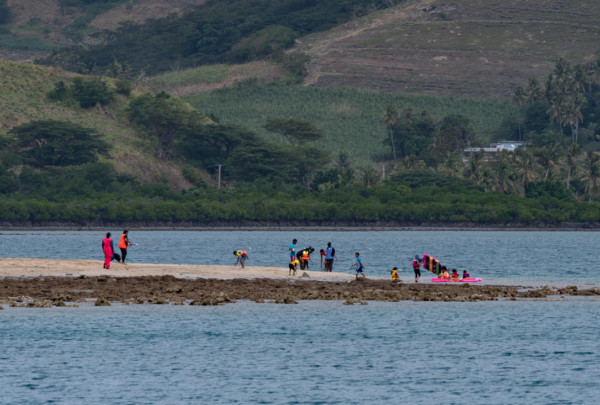
Children playing on Kite Point during a low-low tide. Note the coral that we have to avoid when launching and returning to the point.
The main reason for coming to this area is the kiting-boarding. On the windy days, we spent time at Kite Point. It is best at low tide when there is lots of sand to rig, but it is accessible in any tide.
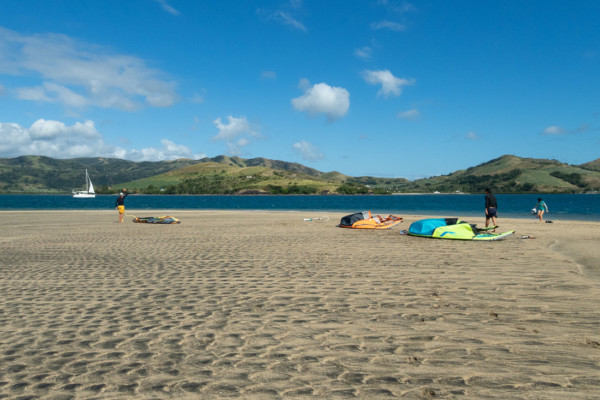
Kite Point at low tide. Mustang Sally sailing passed.
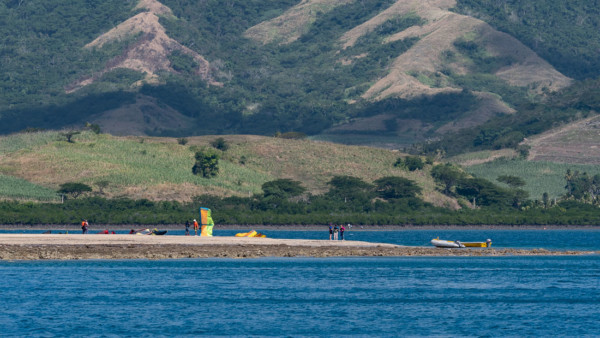
Kite Point at a full moon low tide as seen from our boat.
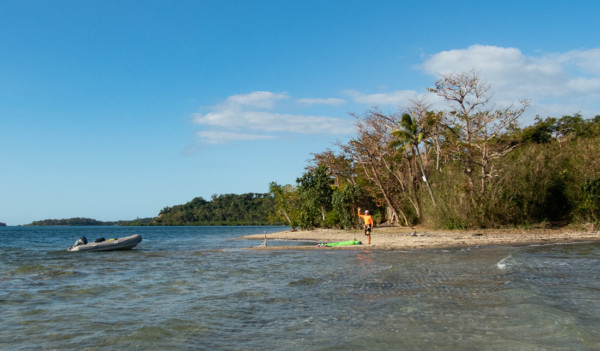
Around full and new moon, the rigging area at Kite Point is pretty small.
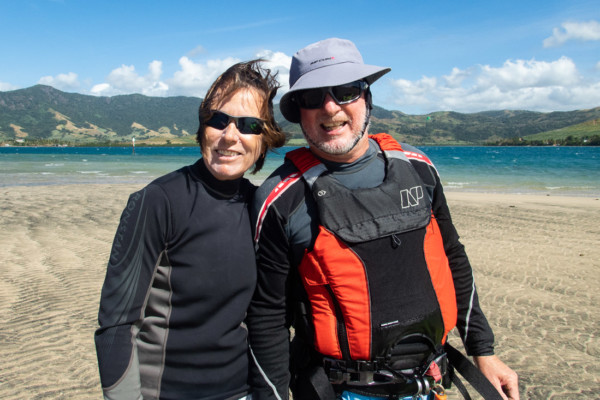
Dianne and Mark from Mustang Sally
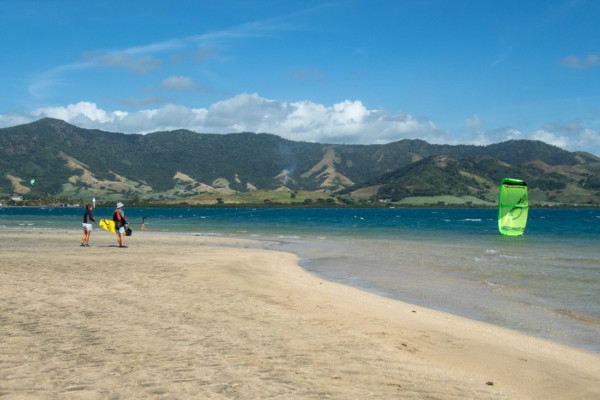
Mark preparing to launch on Kite Point.

Lanie from S/Y Fusio
Most of the time, only three or four kiters were at Kite Point. It was nice to have lots of room to maneuver as a beginner.
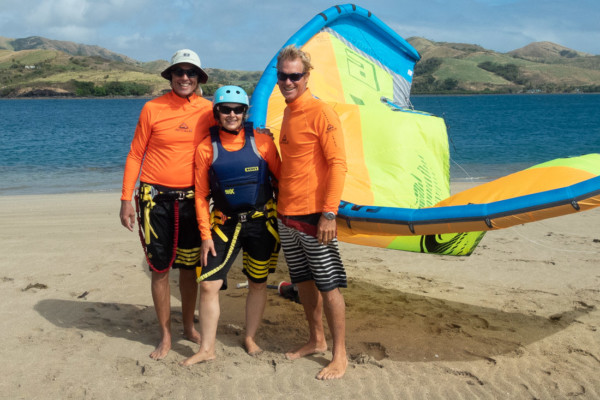
Team Orange, with Warren, from Safari Lodge. The orange thermal tops (from Warren) helped keep us warm. It is winter, after all!
Monty got in numerous kiting sessions, always working on his technique. Warren occasionally gave Monty some tips on jumping and down-loops.
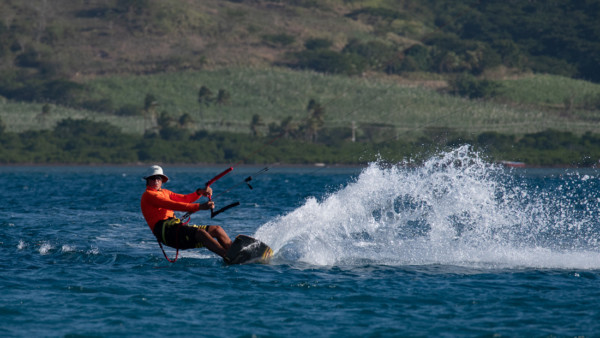
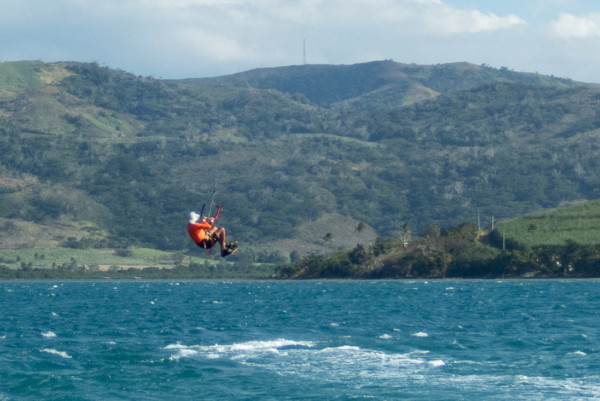
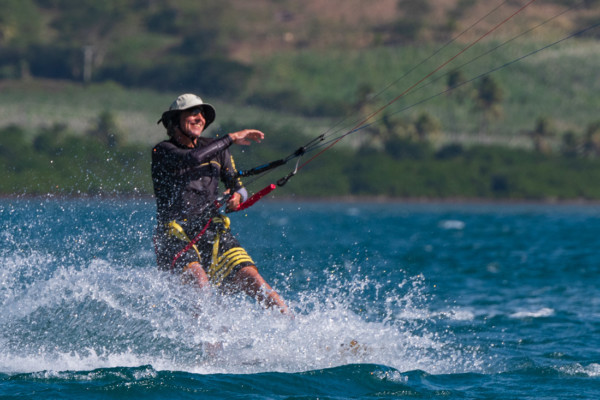
Monty doing a down-loop
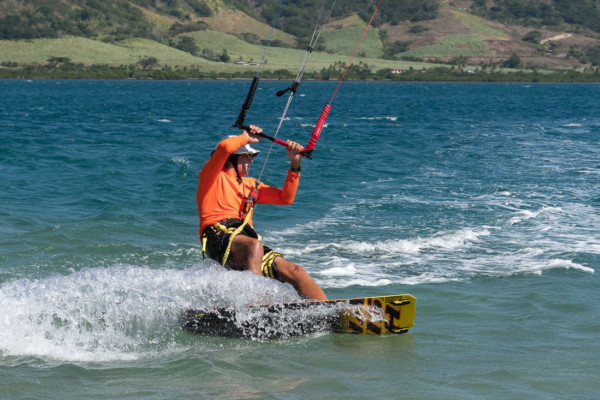
When Warren had free time, I signed up for some lessons.
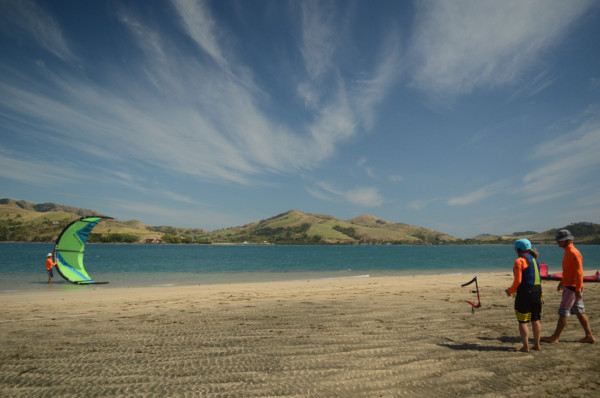
Monty holding my kite while I check my lines, with Warren overseeing. Photo by Marina Guedes.
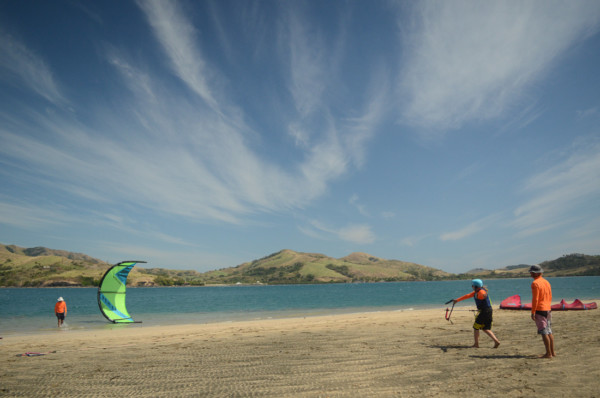
Photo by Marina Guedes.
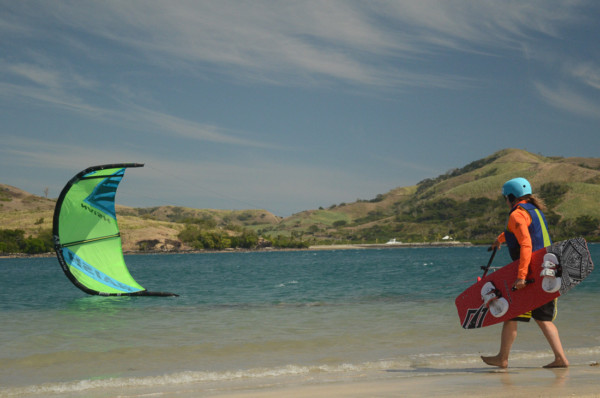
Photo by Marina Guedes.
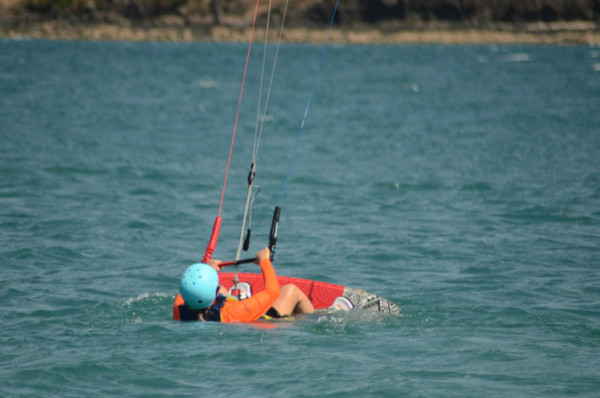
Getting set to water-start. Photo by Marina Guedes.
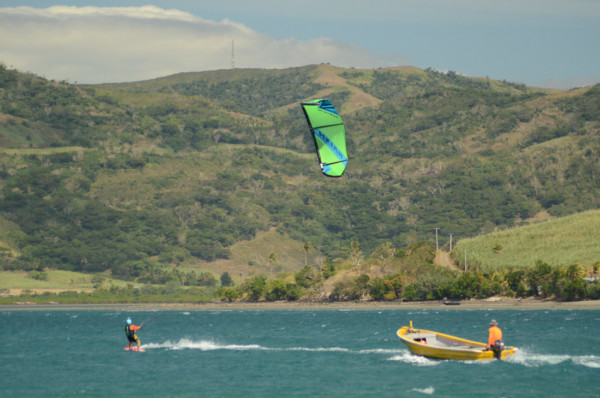
Warren following me in his yellow skiff, giving tips when he was within ear shot. Photo by Monty
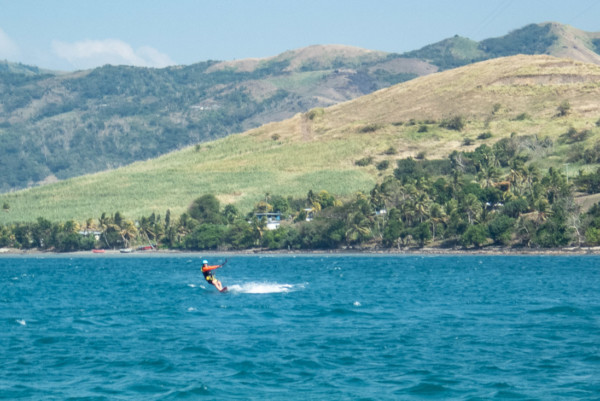
Margy off Kite Point. Photo by Monty
Thanks to Warren for his patience and for teaching me how to kite upwind and make some “dry turns” or transitions. Lots more practice needed, of course, but making progress and feeling more confident.
Warren also took us on some “downwinders”. He takes us out in his skiff to a reef about 5km east of his lodge. He has a well-practiced launching routine. One at a time, we jump in the water with our bars hooked in and lines attached to the kite. We swim away from the skiff to let out our kite lines while Warren pumps up our kite. We tighten our kite lines to check that they are “clean” (with no twists). Then he lets go of the kite while we launch it.
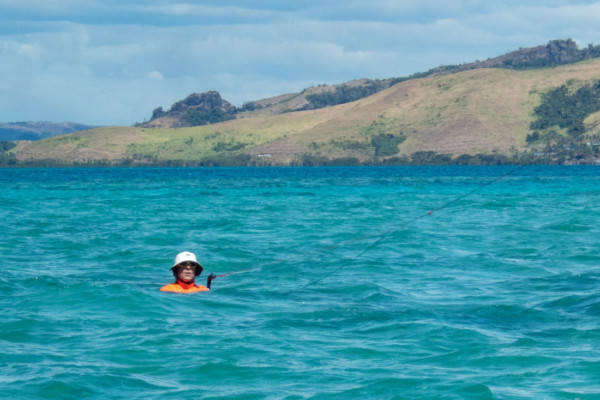
Monty checking his kite lines.
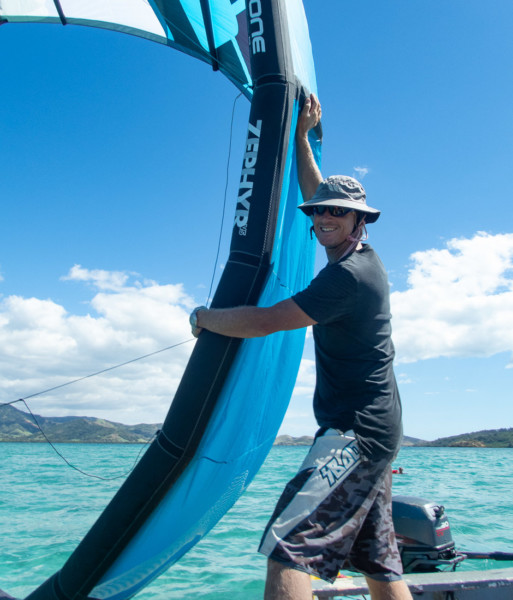
Warren helping to launch Monty’s huge 17m kite on a fairly light wind day.
We body drag closer to the boat so that he can throw us our board. Off we go, tacking back and forth along the reef where the water is flattest.
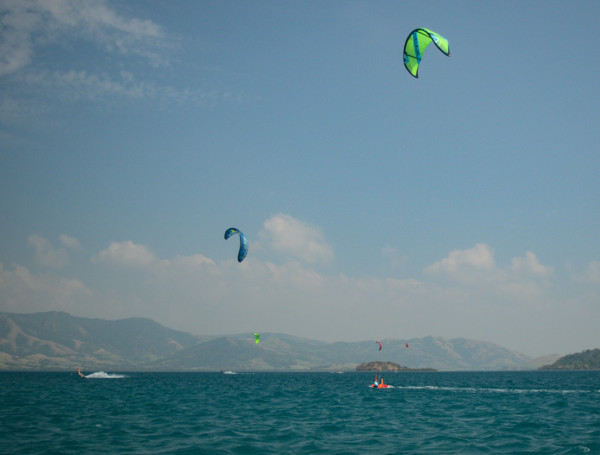
Kiting on the downwinder. Photo by Marina Guedes. Margy water starting on the right, first time kiting with the 14m kite. Monty with the blue kite on the left.
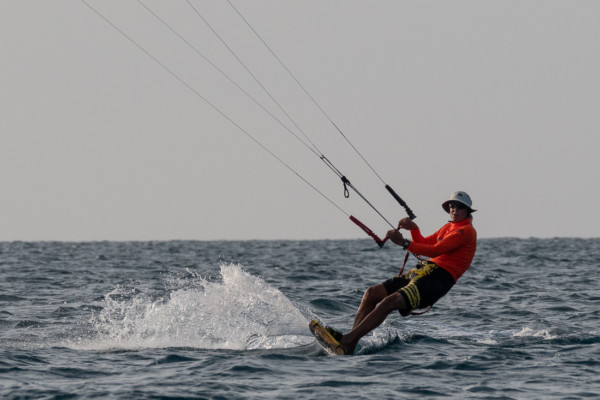
Monty on a downwinder.
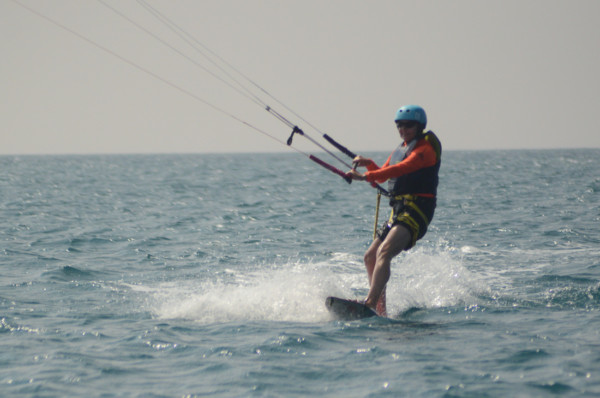
Margy kiting by the skiff. Photo by Marina Guedes.
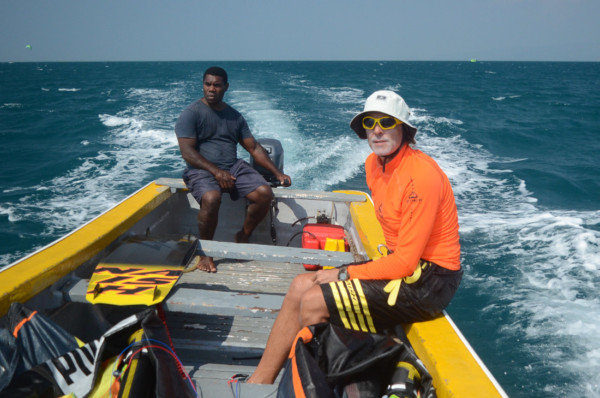
Monty (coated in sunscreen) in the skiff with Warren’s boatman, Aniti. Photo by Marina Guedes.
We tack back and forth, gradually kiting downwind to the beach in front of Safari Lodge. It was great for me to be able to practice riding and controlling my kite on longer runs. If we got cold or wanted to rest, Warren or his boatman would pick us up.
Other activities during our stay at Nananu-I-Cake included 2 or 3 trips to Rakiraki to provision. It is only a 20-minute taxi ride from a nearby wharf. We picked low wind days for a smooth dinghy ride to the wharf! The produce market is quite good and reasonable. We found green beans, papaya, pineapple, mandarins, lemons, limes, tomatoes, cauliflower, bokchoy, Japanese eggplant, hot chilli peppers, onions, potatoes and eggs. At the grocery stores in town we bought frozen chicken, prawns and shoulder lamb chops. Indian cooking ingredients are abundant as the majority of the local population is Indian Fijian. We love curries so we didn’t starve!
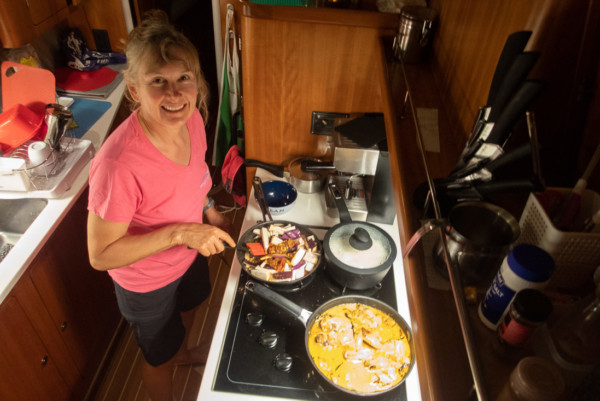
Margy cooking up a couple Indian curry dishes.
Over our 7 week stay, we only had a half dozen “sundowners” and lunches, and just two dinners off Whistler! Lucky for me, Monty likes to cook. I am thankful for his upbringing which had a definite foodie focus.
Monty had a tooth that needed attention, so we took a land trip to Suva by taxi for a dental appointment and some shopping. See the blog called “Suva Excursion” for more on that trip.
Monty went diving with Wananavu Dive a couple times. I had a head cold so I bowed out. The dive boat took his group 18nm east to Vatu-I-Ra reef. He said it was excellent. It was much more expensive than diving at Cousteau or Paradise, a deterrent to doing more diving.
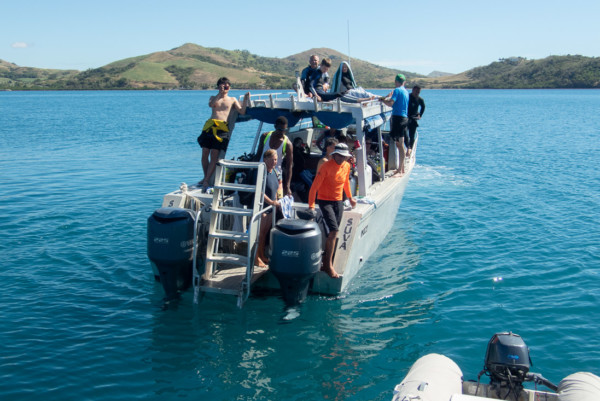
Monty being dropped off the dive boat.
On calm days, we tried snorkelling at a few spots Warren recommended. We saw lots of healthy soft and hard coral and a variety of reef fish and creatures. More on that soon.
Over the 7 weeks, Monty cleaned the props, shafts and bottom a couple times. The hulls were not in bad shape, with only soft growth and a few barnacles. The bridle and anchor chain were also covered in thick soft growth and needed a serious scrub before coming back on board.
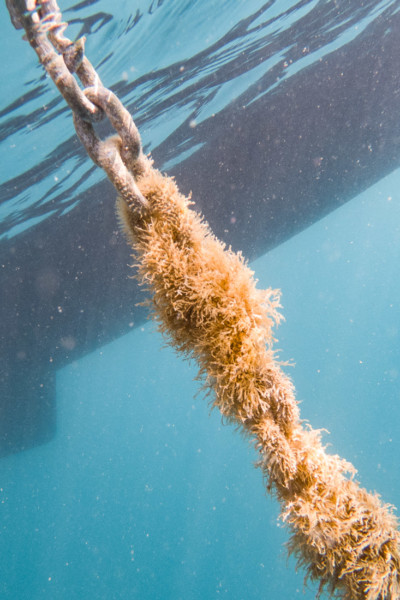
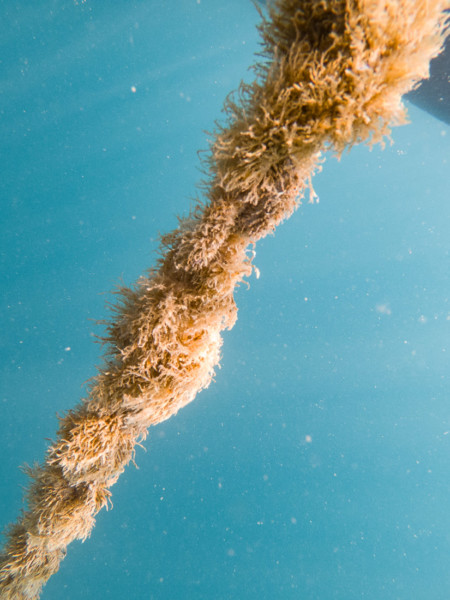
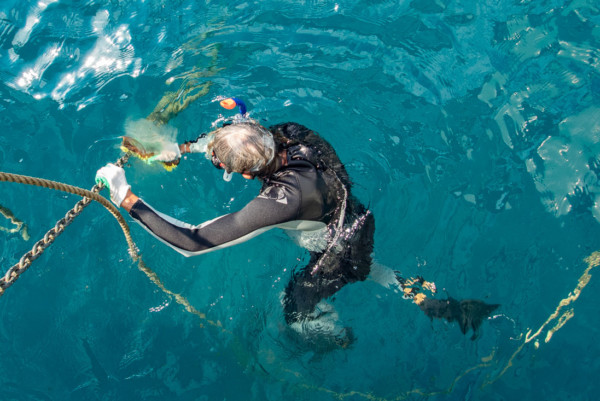
Monty scrubbing the chain to remove the growth. Good exercise with the current in the anchorage!
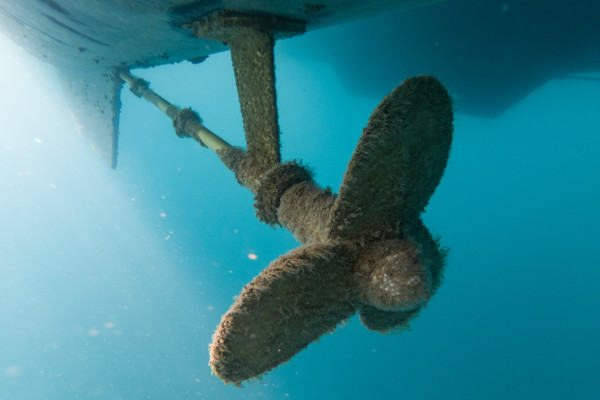
Two weeks of growth on the prop.
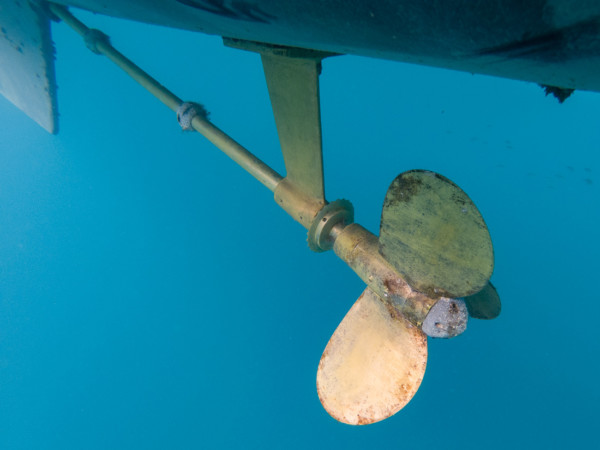
After cleaning.
We also took a two-hour drive to Lautoka to apply to extend our visitors’ visas and do some shopping. Stay tuned for a blog on that.
The Nananu anchorage was a cross-roads, a convenient stop for boats travelling east or west. Going east to Savusavu or Makongai can be tough if the trade winds are blowing so most yachts would wait for the winds to die down. Sometimes Whistler was alone, and other times there were more than a dozen boats in the large, safe anchorage. Yachts with kiters on board like Fusio, Mustang Sally, Blinder, Libeccio, Amici and Roxanne stayed for a while and kited with us when conditions were right. Blue Summit, Invictus and Chara stopped for a few days or a week, to say hi or to wait for a passage window. We made some new acquaintances with crews on Enchantress, Meccatroy and L’Esprit de la Mer too.
While we were at Nananu-I-Cake, the Manoro Volcano on Ambae Island in Vanuatu erupted. 10,000 inhabitants were told to leave their homes under a mandatory evacuation of the entire island’s population. The ash from the volcano over 500 miles away made its way to our boat. We had lots of cleaning to do inside and out but it produced some lovely sunsets. Where we originally anchored, land blocked our view of the sun on the horizon, but I caught this one from Warren’s skiff on the way back from his lodge. We saw the sun setting on the horizon a few other times when invited over to Amici and Blue Summit.
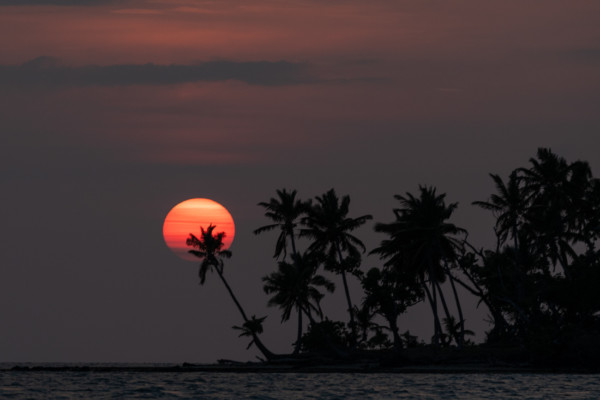
July 23, 2018 from Warren’s skiff
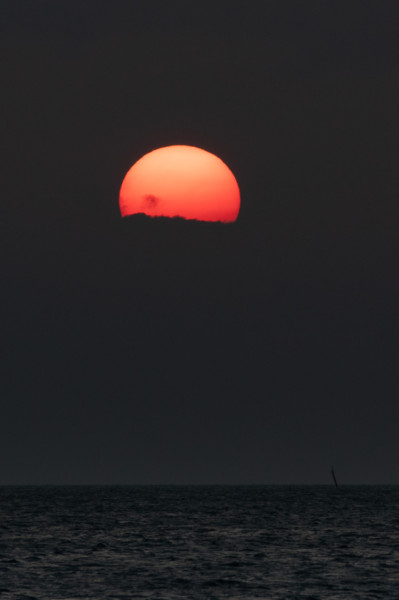
Zooming in, August 1, 2018 from Blue Summit’s cockpit
On August 5th, I convinced Monty we should move anchoring spots, just to ensure we could raise the anchor after all this time in the sticky mud. The other reason was to better position Whistler for the sunsets, something I had been bugging him about for a couple weeks. We took our time nudging the anchor out of the thick mud bottom.
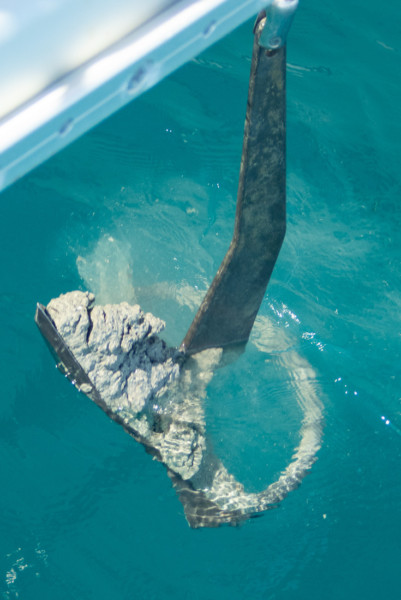
Our anchor with luscious mud from the bottom. Anyone want a Fijian mud facial? Great holding!
Kite Point was now a mile away. Monty complained he could not see the white caps off Kite Point, so he had to make a run over there in the dinghy to check the wind. I doubt we will be anchoring this far away again.
Smoke from grass fires and burning of cane on Viti Levu lit up the hills most evenings. In the mornings, our boat was often covered in black ash. It does not compare with the smoke from tragic wild fires back home in British Columbia, so we can’t complain!
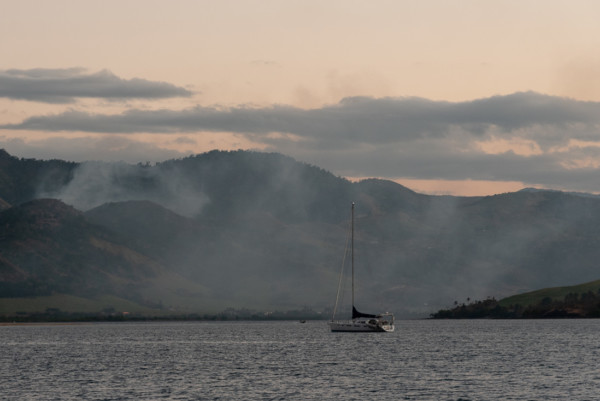
S/Y Roxanne with the smokey mainland in the background.
The haze from the volcanic ash had dispersed and low cloud limited our view of the sunsets on a few nights. However, we did enjoy a couple nice sunsets in the new spot, thanks to smoke from local grass fires!
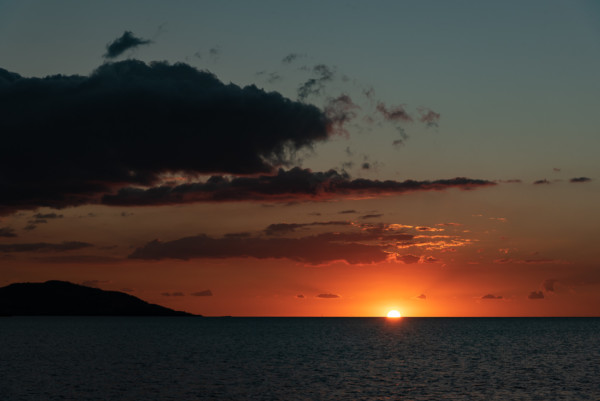
August 6th.
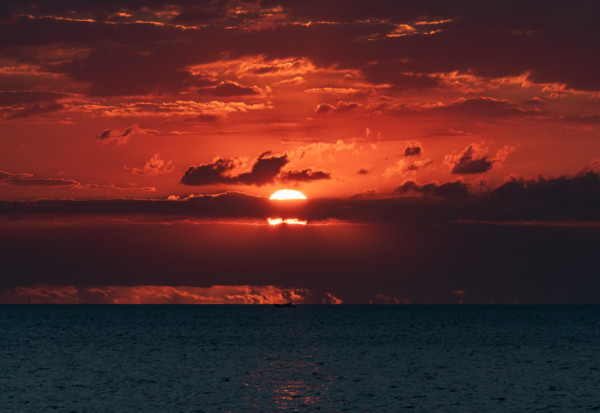
A sunset from our new anchorage, August 7, 2018
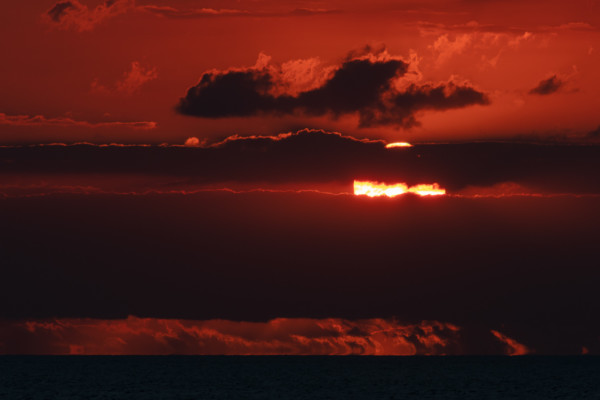
Zooming in, seconds later, August 7, 2018
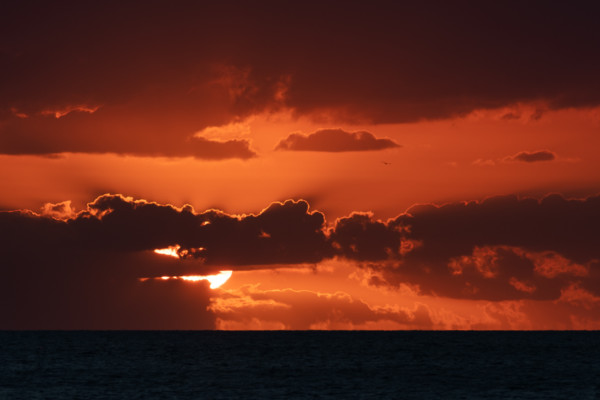
August 8, 2018
We had good times at Nananu-I-Cake and made a friend in Warren from Safari Lodge. He has been in Fiji for 27 years and knows his way around. He was like our personal concierge, helping whenever we asked! In addition to teaching kiting, he invited us to join his lodge guests on downwinders and an awesome snorkel outing, picked up parts for Whistler from Port Denarau, sourced a propeller for our dinghy engine, thermal shirts and water-sport sunglasses, informed us on how to get provisions in Rakiraki, treated us to a lunch and a couple beers at his lodge, did a few laundry loads of bulky towels, gave us a basil plant from his garden and provided lots of levity with his jesting and jokes. How he finds time to do all he does in a day is amazing.
When we started the engines to move the boat a third of a mile north, Monty noticed a leak coming from the raw water pump on the port side engine. Monty did what he could, but it was determined that some bearings and seals needed to be replaced. Not a big job, but better done by a professional with special equipment. It was finally time to move on to busy Port Denarau. We were lucky to be able to reserve a mooring there for a few days. It was hard to leave this friendly and familiar spot. Maybe we will make it back again this season. There are worse places to spend time! We will see where the wind blows us!

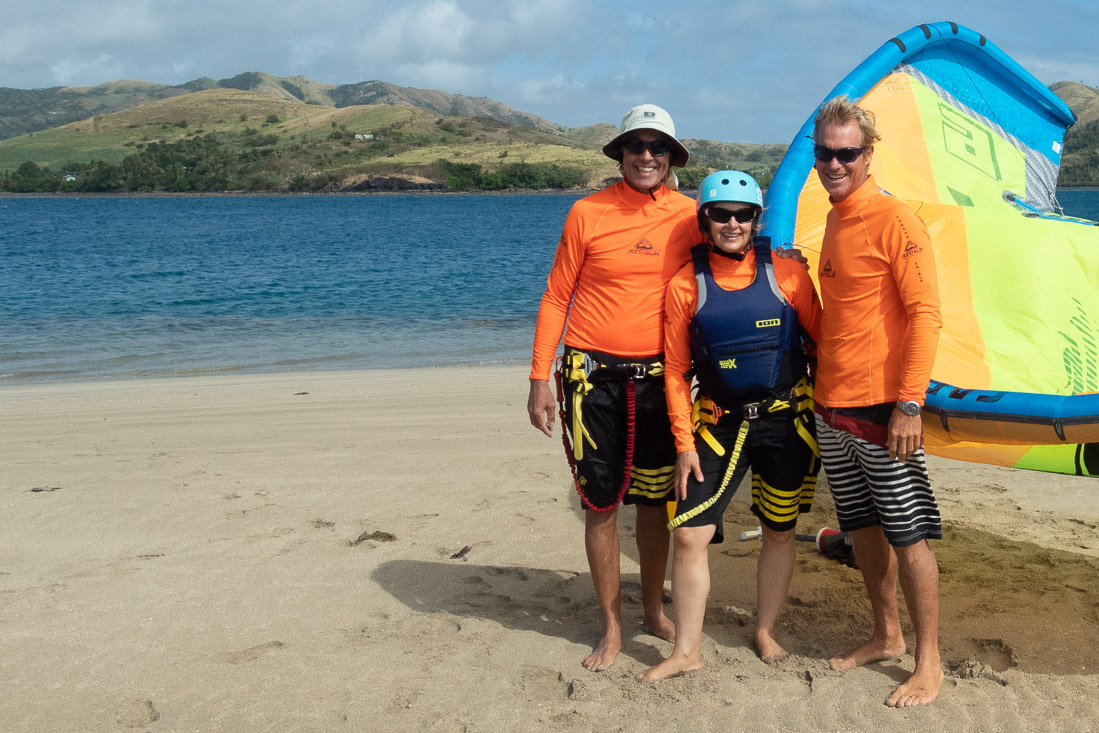


4 comments
It looks like your kiting skills have gone to “expert” and a far cry from wandering around the lagoon with you in Tonga when you were !! Certainly Nananu-I -Cake looks a fantastic spot and you obviously enjoyed it given how long you stayed. I may have to check out your kite instructor rates in the event that we manage a catch up again some time in the future. Always love reading of your adventures!!
Thanks for sharing your sailing adventures. I am off to Europe for 6 weeks soon, visiting Lyon, then Alpine hiking the Mont Blanc Trek (100 miles around the Mountain, 14 days from France to Italy to Switzerland & back to France) using Sherpa Expeditions & they arrange accommodation & move the luggage. Next is Croatia for a 2 week charter on a Sunsail 444 from Dubrovnik to Split & back. Finally to Brussels & Rome for a further week. See you guys in Whistler November onward. John
Love the photos as usual Margy! Like skiing and golf, I see you have both found another obsession. I can’t believe the growth on the anchor chain and prop – looks like you have been there for years. At least it is not black and sludgy like in our waters.
Great stories for the senior home! Talk soon, Carol
Correct me if I’m wrong, Nananu I Cake is a private island, does that mean that the Swiss family that owns it allows beach access, or are all Fijian beaches accessible to anyone?